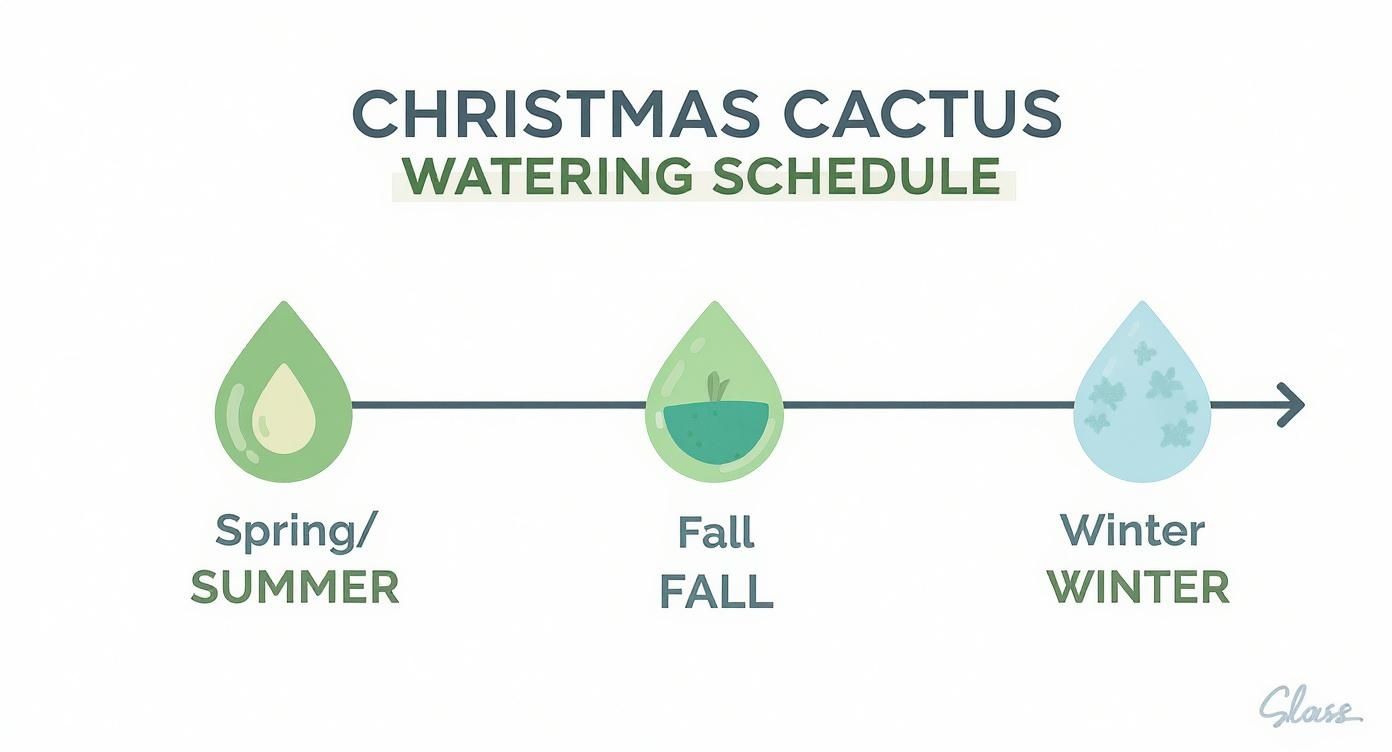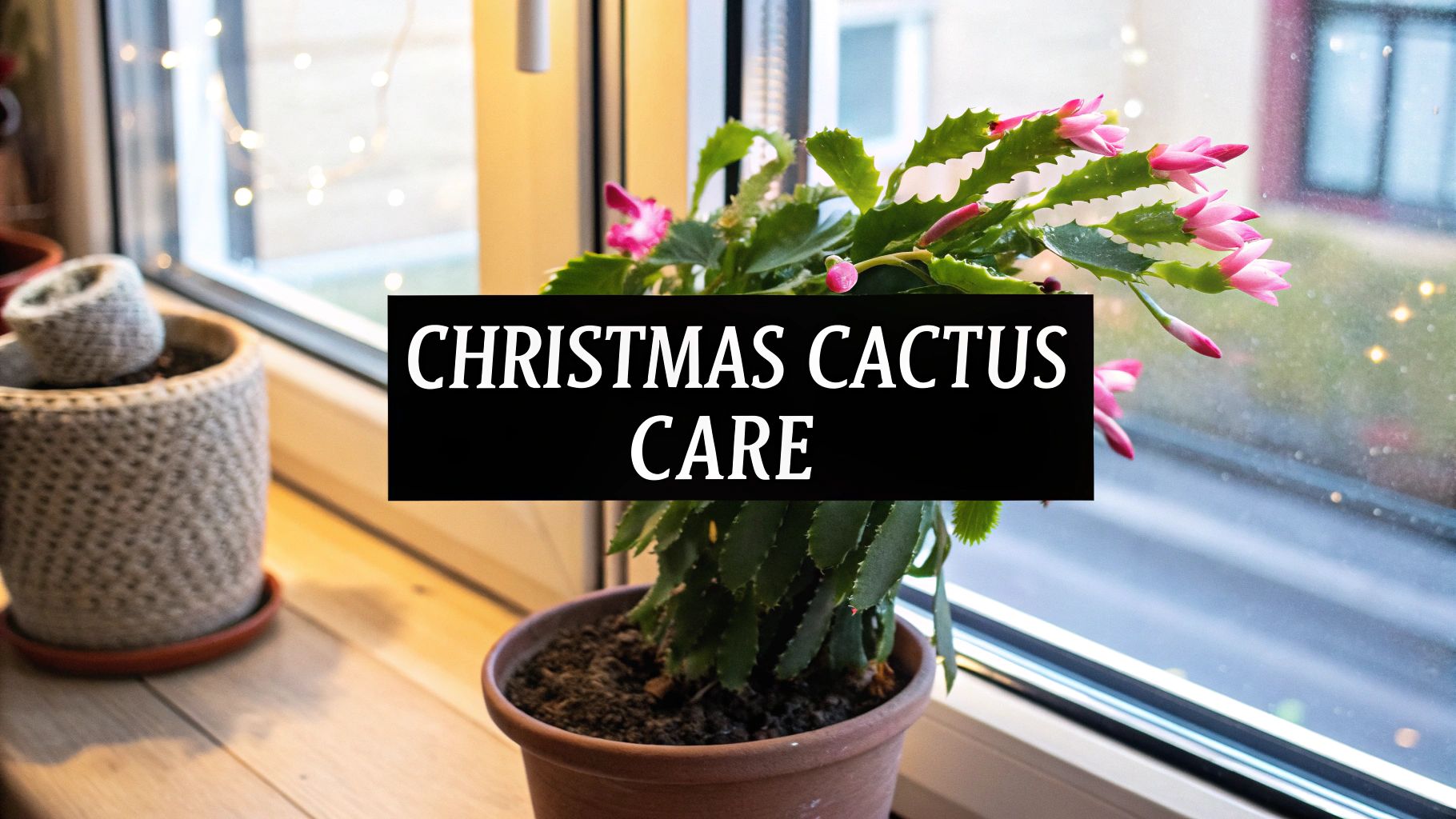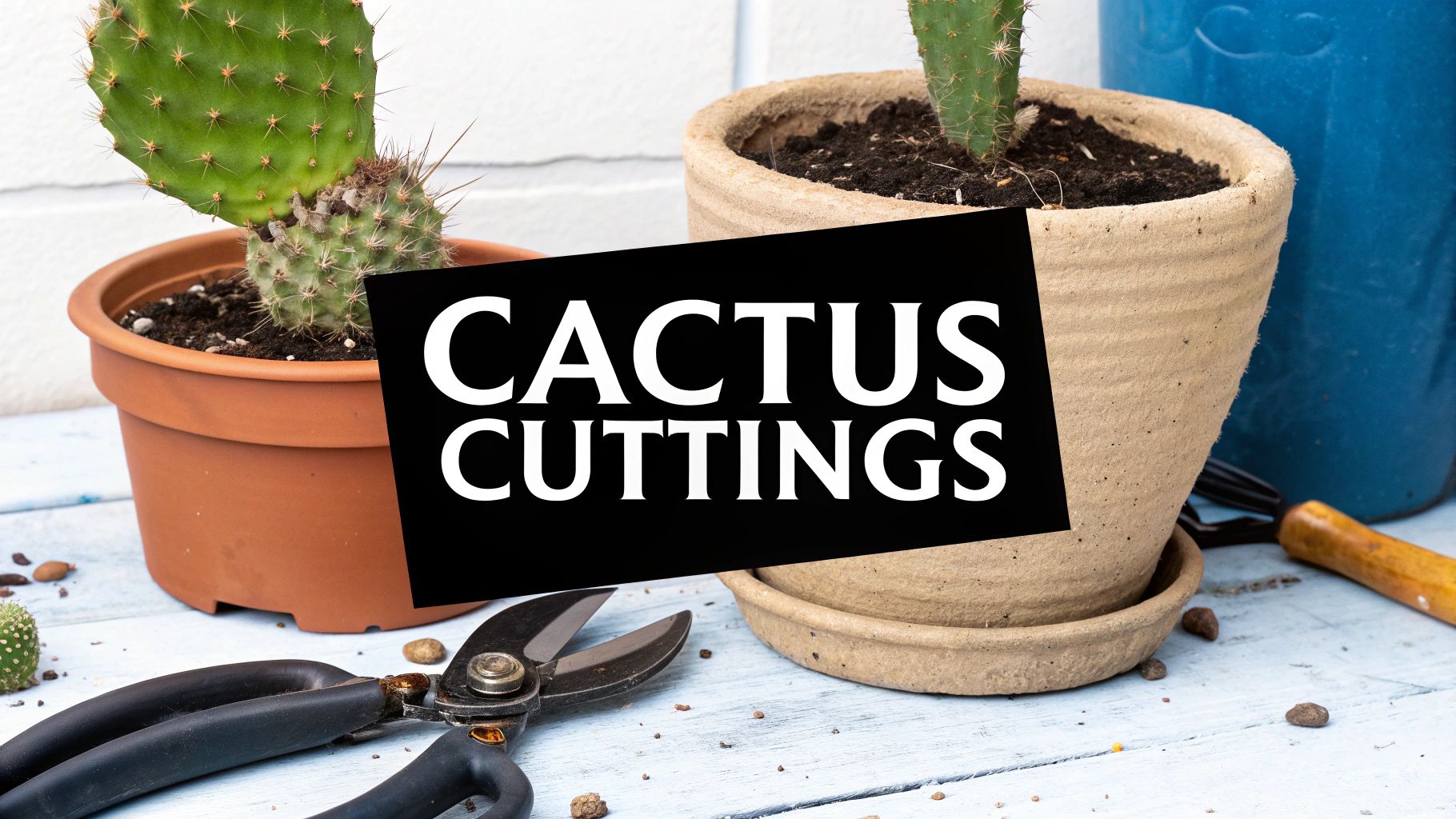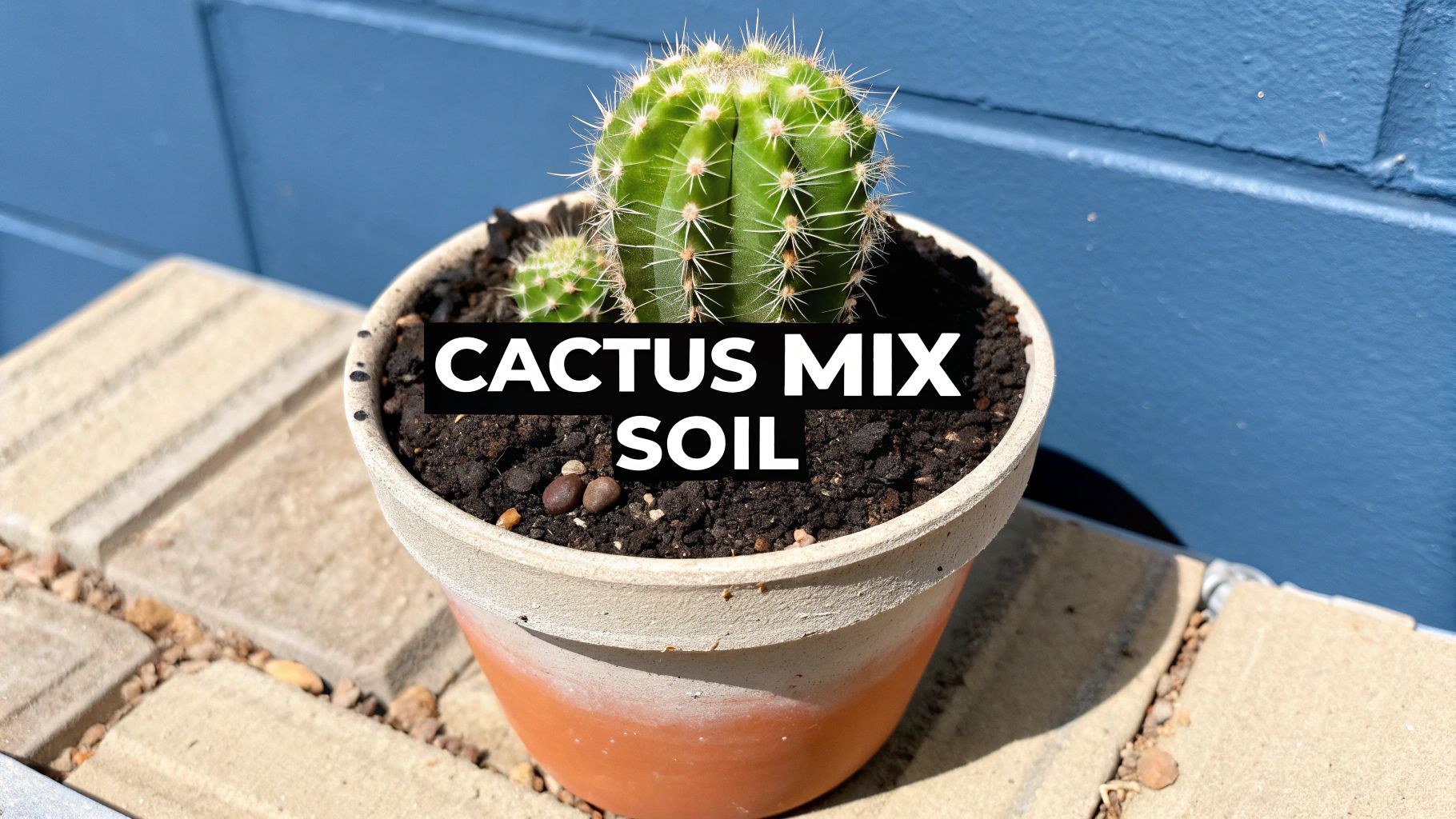The first thing you need to know about your Christmas cactus is a bit of a shocker: it isn't really a cactus. At least, not in the way we usually think of them. This plant is actually a tropical succulent hailing from the rainforests of Brazil, and that one fact changes everything about how you should care for it.
Getting this right is the secret to a happy, blooming plant.
Your Christmas Cactus Is Not a Desert Dweller
When you hear "cactus," you probably picture a spiky plant baking in the desert sun. It's a natural assumption, but applying that logic to a Christmas cactus is a recipe for disaster. Honestly, this plant has more in common with an orchid or a fern than it does with a classic Saguaro.
The scientific name is Schlumbergera, and in the wild, it's an epiphyte. That's a fancy word meaning it grows on other plants, not in the ground. It tucks itself into the nooks of tree branches, clinging to bark and thriving under the dense forest canopy.
This little bit of botany tells you everything you need to know:
- Filtered Light: It's used to the dappled sunlight of a forest floor, not harsh, direct rays.
- Higher Humidity: Rainforests are humid! It loves more moisture in the air than your average succulent.
- Moist Soil: Its roots are adapted to catch rainwater and decaying leaves, so it prefers soil that stays consistently moist but never soggy.
Once you start thinking of it as a jungle plant instead of a desert survivor, the care just clicks.
Is it a Christmas, Thanksgiving, or Easter Cactus?
Just to keep things interesting, the plant sold as a "Christmas" cactus might actually be a Thanksgiving or Easter cactus. They're all close relatives but have small differences in their leaf shapes and when they decide to bloom. Figuring out which one you have can help you time its care perfectly.
- Thanksgiving Cactus (Schlumbergera truncata): This is the one you'll see most often in stores. Its stem segments have sharp, pointy, almost claw-like edges. True to its name, it usually blooms in late fall.
- Christmas Cactus (Schlumbergera bridgesii): A genuine Christmas cactus has softer, scalloped, more rounded edges on its segments. It blooms a little later, right around the Christmas holiday.
- Easter Cactus (Hatiora gaertneri): This one is easy to spot by its very smooth, rounded segments and star-shaped flowers that appear in the spring.
Their care routines are nearly identical, but knowing the type explains why your plant might be flowering in November instead of late December. If you're curious to learn more, you can explore the many fascinating types of succulents and cacti.
Recreate Its Rainforest Home
The goal is simple: try to mimic its native Brazilian environment right in your living room. In the wild, it enjoys filtered light, high humidity, and consistent warmth. Aim for a temperature range between 65°F and 75°F (18-24°C), with nights being just a little bit cooler. This mimics the day-night cycle it's used to.
If you remember one thing, make it this: Your Christmas cactus is a tropical, tree-dwelling plant. Keep it out of direct sun, don't let the soil turn to dust, and toss out everything you thought you knew about desert cactus care. That's the foundation for a gorgeous plant that will gift you with flowers year after year.
Mastering Light, Water, and Soil Conditions
Getting the environment right is where the magic really happens with a Christmas cactus. It’s the difference between a plant that just hangs on and one that absolutely thrives, putting on that spectacular holiday show you’re waiting for. Let's dig into the nitty-gritty of light, water, and soil so you can give your plant the perfect foundation.
Finding the Perfect Light
First things first, forget everything you know about desert cacti. These are tropical, rainforest plants, and they will absolutely scorch in direct, blazing sun. Picture them in their native Brazil, tucked under a lush tree canopy where they only get dappled, bright-but-indirect sunlight. That’s the vibe we're going for.
An east-facing window is usually the sweet spot. It offers a few hours of gentle morning sun that won't burn those delicate, flattened stems (which are called cladodes, by the way). A north-facing window is another great option, providing consistent, soft light all day long.
What if you only have a south or west-facing window? No problem, you just need to play defense. Move the plant a few feet back from the glass or hang a sheer curtain to filter that intense afternoon light.
A Little Plant-to-Human Translation: Your cactus will tell you if the light is off. If the segments start getting a reddish or purplish tinge, it’s basically getting a sunburn. On the other hand, if it looks pale and stretched out, it's begging for a bit more light.
The Art of Watering Your Christmas Cactus
This is where most people trip up. It's so easy to kill these plants with kindness—specifically, too much water. Remember, in the wild, they get drenched by tropical rain and then their roots quickly dry out in the open air. They are not built to sit in dense, soggy soil. Overwatering is the #1 killer, leading straight to root rot.
The best tool you have is your own finger. Just stick it about an inch deep into the soil. If it feels dry, it’s time to water. If you feel any moisture at all, hold off for a few more days and check again. This simple 'finger test' is way more reliable than watering on a rigid schedule.
When you do water, be generous. Let the water run through the soil until it streams out of the drainage holes. This ensures the entire root ball gets a good drink. But here's the crucial part: after 15-20 minutes, dump out any water that’s collected in the saucer. Letting your plant sit in a puddle is the fastest way to invite root rot.
The plant's thirst will change throughout the year, so it's helpful to know what to look for each season.
Christmas Cactus Watering Schedule by Season
This table breaks down how to adjust your watering routine to match the plant's natural cycle of growth, budding, and rest.
| Season / Growth Stage | Watering Frequency | Key Indicator |
|---|---|---|
| Spring & Summer (Active Growth) | More frequently; when the top inch of soil is dry. | You'll see new, bright green segments forming on the tips. |
| Fall (Bud Formation) | Reduce frequency slightly; allow soil to dry out a bit more. | This slight stress encourages the plant to set flower buds. |
| Winter (Blooming & Post-Bloom) | Keep soil evenly moist, but not soggy. | Water consistently to prevent bud drop during flowering. |
Keeping this cycle in mind helps you stay in sync with your plant's needs, promoting both healthy growth and beautiful blooms.
Creating the Ideal Soil Mix
You can't just grab any old bag of soil and expect your Christmas cactus to be happy. Standard "cactus and succulent" mixes are actually a terrible fit. They’re designed for arid plants and are often too dense and sandy for a Schlumbergera, leading to compacted, suffocated roots.
What you need is a blend that's rich in organic material but also super airy and fast-draining. You're trying to copy that mix of bark and decaying leaves it would naturally grow in. Thankfully, whipping up the perfect batch at home is incredibly easy.
For a soil your Christmas cactus will absolutely love, just mix these three ingredients:
- 2 parts high-quality all-purpose potting mix
- 1 part perlite or pumice
- 1 part orchid bark
This recipe creates a chunky, light, and perfectly balanced medium. The potting mix provides nutrients, the perlite keeps it from getting compacted, and the orchid bark is the secret weapon for amazing aeration. It’s a game-changer for long-term root health.
How to Trigger Holiday Blooms Consistently
Seeing your Christmas cactus explode in a cascade of jewel-toned flowers is what it's all about. That stunning display isn’t just luck; it’s a direct response to specific environmental cues that you can control. Once you understand how to "trick" the plant into its blooming cycle, you can get a reliable show right on schedule for the holidays.
The whole process comes down to convincing your cactus that winter is on its way. This means manipulating two key factors: longer nights and cooler temperatures. By recreating these classic autumn conditions, you’re sending a clear signal that it's time to stop putting out new leaves and start making flower buds.
The Two Triggers for Abundant Flowers
To pull this off, you'll need a game plan that kicks in during the fall. I find that starting around mid-September to early October is perfect. This gives the plant a solid six to eight weeks to develop its buds before the holiday season really gets going.
You have two main levers to pull:
- Extended Darkness: This is, without a doubt, the most important factor. Your cactus needs 13 to 14 hours of absolute, uninterrupted darkness every single night. I mean total darkness—even a quick flash from a lamp or a street light peeking through the blinds can reset its internal clock and stop bud formation in its tracks.
- Cooler Temperatures: A dip in temperature really drives the message home. Try to give it a consistent nighttime temperature between 50°F and 55°F (10-13°C). This cool-down period works hand-in-hand with the long nights to get the best possible bud set.
Mastering this seasonal rhythm is the secret to successfully caring for a Christmas cactus.
Creating the Perfect Blooming Environment
Don't worry, achieving these conditions is much easier than it sounds. You don’t need a special greenhouse; a spare room, a cool basement, or even a closet will work just fine. An unused guest bedroom is often a great choice. You can simply move the plant there in the evening and bring it back to its normal spot with bright, indirect light in the morning.
No spare room? No problem. A simple cloth cover works just as well. Just drape a dark, breathable cloth or even a big paper bag over the plant each evening to create that total darkness, and then take it off in the morning. It's a low-tech but highly effective method for mimicking the shorter days of fall. If you’re struggling to get the light just right, check out our detailed guide on how much sunlight a Christmas cactus needs to help fine-tune its daily exposure.
This isn't just folk wisdom; it's backed by horticultural science. Commercial growers have this down to a science to make sure their plants are blooming perfectly for holiday shoppers. They know that the ideal photoperiod is around 13 to 14 hours of darkness, combined with 6 to 8 weeks of those cooler temperatures to force the plant into flower.
Preventing the Dreaded Bud Drop
Once you spot those tiny pinkish buds forming at the tips of the leaf segments, you can breathe a sigh of relief and stop the darkness treatment. Your hard work paid off! But you’re not quite out of the woods yet. The next challenge is keeping those precious buds on the plant until they open. The dreaded "bud drop" is a frustratingly common problem.
Bud drop is simply a stress response. If the plant experiences any sudden, jarring changes in its environment, it will shed its buds as a survival mechanism.
Key Takeaway: Consistency is your best friend once the buds appear. Abrupt shifts in temperature, light, or watering can make the plant panic and jettison its buds before they ever have a chance to open.
To keep this from happening, stick to these simple rules:
- Keep It Stable: Find a good spot for your cactus and leave it there. Don't move it around the house.
- Water Carefully: Stick to a consistent watering routine. Let the top inch of soil dry out, then water it well. Both letting it get bone dry and keeping it waterlogged will cause stress.
- Avoid Drafts: Position the plant away from drafty windows, heating vents, or fireplaces where it can get hit with sudden hot or cold air.
This infographic gives you a great visual for adjusting your watering habits throughout the year to support every stage of the plant's life.

As the timeline shows, you'll want to reduce watering in the fall to encourage blooming, then ramp it back up to a more consistent schedule during the winter to sustain those beautiful flowers.
Nurturing Your Plant for a Long and Beautiful Life
https://www.youtube.com/embed/P3RxhwkF9Co
Beyond the daily rhythm of light and water, a few key maintenance tasks are what truly transform a Christmas cactus from a fleeting holiday decoration into a cherished family heirloom. Getting the feeding, pruning, and repotting right is the secret to unlocking decades of vibrant blooms. Thankfully, these steps are far simpler than they sound.
Christmas cacti are famous for their incredible lifespan. While you can expect a well-cared-for plant to live for 20 to 30 years, many have been known to survive for over a century, passed down from one generation to the next. You can read more about the astounding longevity of these plants and see just how they become a living part of a family's history.
A Simple Feeding Plan
When it comes to fertilizer, timing is everything. The goal is to give your cactus nutrients when it's actively growing and then ease off to encourage it to focus its energy on flowering. A standard, water-soluble houseplant fertilizer works perfectly—just be sure to dilute it to half-strength.
I like to think of the feeding schedule in two distinct phases:
- Growing Season (Spring through Summer): This is when you'll see your plant pushing out new, bright green leaf segments. From about April through September, feed it once a month with your half-strength fertilizer. This gives it the fuel needed for healthy new growth.
- Blooming Season (Fall and Winter): Around the end of September, stop fertilizing completely. This mild stress, combined with the shorter days and cooler nights, is the natural trigger that tells the plant to stop making leaves and start forming flower buds.
After the last flower has faded, usually in late winter, let the plant rest for about a month before you start the feeding cycle again in the spring.
How to Prune for a Fuller, Greener Plant
Pruning is one of the easiest—and most rewarding—things you can do for your Christmas cactus. It encourages the plant to branch out, which results in a much fuller, bushier shape and, most importantly, way more flowers next season. The best time to prune is about a month after it finishes blooming.
You don’t even need any special tools for this.
- Look for a longer stem and decide where you want to encourage new growth. A good spot is usually one or two segments back from the tip.
- Hold the segment you want to keep firmly with one hand.
- With your other hand, gently twist off the end segment (or two). It should pop off cleanly right at the joint.
That's it! This simple little twist signals the plant to send out two new branches from the spot you pruned. As a bonus, those little segments you removed can be easily rooted to grow whole new plants.
The Art of Repotting
One of the best things about Christmas cacti is how little they ask for when it comes to repotting. In fact, they bloom best when they are a little bit pot-bound, meaning their roots are snug in the container.
You'll probably only need to repot your plant every 3 to 5 years, maybe even less for a very mature one. A common mistake is moving them into a bigger pot too soon. This can lead to the soil staying wet for too long, creating the perfect conditions for dreaded root rot.
How do you know it's time? Watch for these signs: the plant looks top-heavy and unstable, water seems to run straight through the pot without soaking in, or you can see roots creeping out of the drainage holes.
When you do repot, choose a new container that is only 1-2 inches wider in diameter than the old one. After you've settled it into its new home with some fresh, well-draining soil, hold off on watering for about a week. This gives any roots that were bruised during the move a chance to heal. If you want a refresher on the basics, our guide on how to properly repot cacti is a great resource. This patient approach is what helps your plant thrive for years to come.
Troubleshooting Common Christmas Cactus Problems
Even the most seasoned plant parent runs into trouble now and then. Your Christmas cactus is pretty tough, but it will definitely let you know when it's unhappy. The trick is learning to speak its language and figuring out what its signals—like wilting leaves or dropping buds—really mean.
Don't worry if you see something amiss. Most of the time, these are easy fixes once you pinpoint the problem. Let’s walk through the most common issues and how to get your plant back on track.
Why Are My Flower Buds Falling Off?
It's a classic Christmas cactus tragedy: the plant is covered in beautiful, promising buds, and then one day they're all over the floor. This is called bud drop, and it’s almost always a sign of stress from a sudden change.
Your cactus gets comfortable in its environment, especially when it's gearing up to bloom. Any abrupt shift in its routine can make it panic and ditch the flowers to save energy. The usual suspects are:
- Sudden Temperature Swings: Moving it near a drafty window, a heating vent, or just from a cool spot to a much warmer one can shock it.
- Watering Whiplash: Letting the soil get completely parched or keeping it waterlogged are both major stressors.
- A Change of Scenery: Relocating the plant to a new spot with different light conditions after the buds have already formed is a common trigger.
Once you see those buds start to form, think consistency. Keep its environment as stable as possible, stick to your watering schedule, and don't move it.
Decoding Limp or Wilting Segments
When the segments on your cactus start looking limp, droopy, or shriveled, it's a clear cry for help. This almost always points back to water, but it can be a bit of a puzzle to figure out if it's too much or too little.
- Underwatering: This is the easier fix. If the segments look wrinkled and the soil is literally pulling away from the edge of the pot, your plant is bone dry. Just give it a good, thorough soak until you see water run out of the drainage holes.
- Overwatering: This one is much more serious. If the segments are limp but feel mushy, especially near the base, you're likely dealing with root rot. When roots are waterlogged, they can't "breathe" and start to die off, which ironically means they can no longer absorb water for the plant.
If you suspect root rot, you have to intervene quickly. Slide the plant out of its pot and take a look at the roots. Healthy ones are firm and white, but rotten ones will be brown, mushy, and might even have a funky smell. Using clean scissors, carefully snip off all the dead or mushy parts. Repot your cactus in a fresh, dry batch of well-draining soil and hold off on watering for a few days to let the cut roots callous over.
Spotting and Treating Common Pests
Christmas cacti are generally pest-free, but they can sometimes attract mealybugs. These little pests look like tiny bits of white cotton and love to tuck themselves into the nooks and crannies where the segments connect. They suck the sap from the plant, which can lead to yellowing leaves and stunted growth.
As soon as you see one, move that plant away from any others to keep the problem contained. If it's just a few, dip a cotton swab in 70% isopropyl alcohol and touch it directly to the mealybugs. The alcohol dissolves their protective coating and gets rid of them on contact.
If you're facing a bigger infestation, you may need to spray the whole plant down with insecticidal soap. For more in-depth strategies on keeping your plants safe, the Plantguard resources can be quite helpful. A quick check for pests every time you water is the best way to catch them early.
It can be tough to play detective with your plant. To make it a bit easier, here’s a quick-reference table to help you match the symptoms with the likely cause and solution.
Diagnosing Common Christmas Cactus Ailments
| Symptom | Likely Cause | Solution |
|---|---|---|
| Flower buds drop before opening | Sudden change in temperature, light, or watering | Maintain a consistent environment once buds form. Avoid moving the plant. |
| Limp, wrinkled segments | Underwatering | Water thoroughly until it drains from the bottom. Check soil moisture more often. |
| Limp, mushy segments (especially at the base) | Overwatering and root rot | Check roots, trim any rot, and repot in fresh, dry soil. Adjust watering frequency. |
| White, cottony spots between segments | Mealybug infestation | Isolate the plant. Spot-treat with 70% isopropyl alcohol or use insecticidal soap. |
| Red-tinged edges on segments | Too much direct sunlight | Move the plant to a location with bright, indirect light instead of direct sun. |
| No blooms during the flowering season | Not enough darkness or incorrect temperature | Ensure 12-14 hours of total darkness and cool temps (50-55°F) for 6-8 weeks in the fall. |
Remember, every plant is different, and observing yours is the best way to learn what it needs. These guidelines should give you a great starting point for troubleshooting whatever comes your way.
Got Questions? We've Got Answers
No matter how carefully you follow a guide, plants have a way of throwing us a curveball now and then. Let's tackle some of the most common questions I hear from fellow Christmas cactus growers.
What Does It Mean When the Leaves Turn Red?
Seeing red or purplish leaves on your Christmas cactus is almost always a sign of stress. The most frequent culprit? Too much direct sunlight. Think of it as a plant's version of a sunburn. It’s producing a protective pigment to shield itself.
The fix is usually simple: move it to a spot with that bright, indirect light it craves. If changing its location doesn't solve the problem after a couple of weeks, you might be looking at a less common issue like a magnesium deficiency or a plant that's severely root-bound. A quick check of the roots and perhaps a little Epsom salt in its next watering can do wonders.
Can I Put My Christmas Cactus Outside in the Summer?
You absolutely can! A summer vacation outdoors often does them a world of good, thanks to the fresh air and natural humidity. The key is to find the right spot—think a covered porch or beneath the canopy of a large tree. The goal is to protect it from harsh, direct sun and strong winds.
Don't just toss it outside and hope for the best. To avoid shocking the plant, acclimate it over a week or so. Start with just a few hours outside in a shady spot and gradually increase its time outdoors. And, of course, make sure to bring it back inside long before the first frost hits your area.
How Can I Propagate My Christmas Cactus?
Propagating these plants is one of my favorite things to do—it's incredibly simple and a fantastic way to share your plant with friends.
- First, find a healthy branch and gently twist off a Y-shaped cutting. You want a piece with at least 2 to 4 connected segments. Twisting gives you a clean break right at the joint, which is better than cutting.
- Let the cutting sit out for a day or two. This allows the broken end to dry out and form a callus, which helps prevent rot.
- Then, just stick the bottom segment about an inch deep into a small pot of moist, well-draining soil. In a few weeks, you'll have roots, and a brand-new plant will be on its way!
Is a Christmas Cactus Poisonous to Cats or Dogs?
Good news for all the pet parents out there: the Christmas cactus (Schlumbergera species) is non-toxic to cats and dogs, according to the ASPCA. So, if your curious cat or playful pup takes a nibble, you don't need to panic.
That said, while it won't poison them, munching on any plant can still cause some mild stomach upset. It's always a good idea to keep your plants out of reach of pets who have a habit of chewing on things they shouldn't.
Here at The Cactus Outlet, our passion is helping you grow beautiful, thriving plants that bring you joy for years to come. Take a look at our curated selection of cacti and succulents to find the next standout addition to your home.
Discover your next plant at The Cactus Outlet.




